Harold Park is a place in the London Borough of Havering.
Harold Park is a place in the London Borough of Havering.
Harold Park is north-eastern part of Harold Wood, occupying an isthmus of land between the A12 and the Ingrebourne River (The River Ingrebourne at Harold Park and Hornchurch).
In 1868 [1] a wealthy Brentwood solicitor built himself a mansion to the south of the river and railway line, named Harold Court. After the owner's bankruptcy the house served as a children's home, then a lunatic asylum and then a sanatorium. In 1959 it became a teacher training college and has now been converted into private flats.
Horse Block Farm lay to the north-east of Harold Court Road. After the First World War the Essex builders Iles and Company laid out a bungalow estate here that it called Sunnytown. The company also created Sunnymede at Billericay.
When Harold Court primary school opened in 1929 the area still retained a rural character, but this was slowly eroded as further development plugged the gaps, including some industry beside the Ingrebourne River.
Harold Park was located in the northeastern protrusion of the Hornchurch civil parish. It was part of Romford Rural District until 1926 and was then formed part of Hornchurch Urban District.
Harold Park sits in the Parliamentary Constituency of Hornchurch and Upminster.
Maylands Golf club, Harold Park was founded in 1937 [2]
Harold Park sits on the London/Essex border. [3] The boundary goes down the Weald Brook. This has since changed to go down the M25 to junction 11 and then turn west along the A12 to Putwell Bridge where it joins the Ingrebourne. The River Ingrebourne and the Weald Brook meet in the area of Putwell Bridge. The Ingrebourne then flows south west.
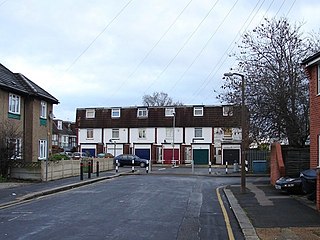
Harold Wood is a suburban neighbourhood of Romford in the London Borough of Havering. It is situated 16.5 miles (26.6 km) east-northeast of Charing Cross and near to the Greater London boundary with Essex.

Hornchurch is a suburban town in East London, England, and part of the London Borough of Havering. It is located 15.2 miles (24.5 km) east-northeast of Charing Cross. It comprises a number of shopping streets and a large residential area. It historically formed a large ancient parish in the county of Essex that became the manor and liberty of Havering. The economic history of Hornchurch is underpinned by a shift away from agriculture to other industries with the growing significance of nearby Romford as a market town and centre of administration. As part of the suburban growth of London in the 20th century, Hornchurch significantly expanded and increased in population, becoming an urban district in 1926 and has formed part of Greater London since 1965. It is the location of Queen's Theatre, Havering Sixth Form College and Havering College of Further and Higher Education.

Romford is a large town in East London and the administrative centre of the London Borough of Havering. It is located 14.1 miles (22.7 km) northeast of Charing Cross and is one of the major metropolitan centres identified in the London Plan. Historically, Romford was a market town in the county of Essex, and it formed the administrative centre of the liberty of Havering before that liberty was dissolved in 1892. Good road links to London and the opening of the railway station in 1839 were key to the development of the town. The economic history of Romford is characterised by a shift from agriculture to light industry and then to retail and commerce.

Upminster is a suburban town in East London, England, within the London Borough of Havering. Located 16.5 miles (26.6 km) east-northeast of Charing Cross, it is one of the district centres identified for development in the London Plan.
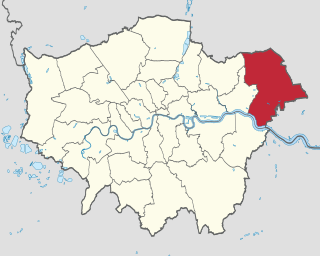
The London Borough of Havering in East London, England, forms part of Outer London. It has a population of 259,552 inhabitants; the principal town is Romford, while other communities are Hornchurch, Upminster, Collier Row and Rainham. The borough is mainly suburban, with large areas of protected open space. Romford is a major retail and night time entertainment centre, and to the south the borough extends into the London Riverside redevelopment area of the Thames Gateway. The name Havering is a reference to the Royal Liberty of Havering which occupied the area for several centuries. The local authority is Havering London Borough Council. It is the easternmost London borough.

Ardleigh Green is an area in east London, England, within the London Borough of Havering. It is 15.5 miles (25 km) east-northeast of Charing Cross. This part of London is predominantly residential.
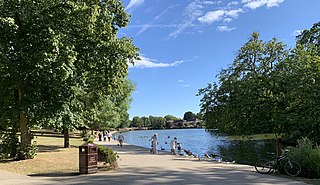
Gidea Park is a neighbourhood in the east of Romford in the London Borough of Havering, south-east England.

Harold Hill is a suburban area in the London Borough of Havering, East London. 16.6 miles (26.7 km) northeast of Charing Cross. It is a district centre in the London Plan. The name refers to King Harold II, who held the manor of Havering-atte-Bower, and who was killed at the Battle of Hastings in 1066. The suburb is peripheral to London, forming an eastern edge of the urban sprawl.
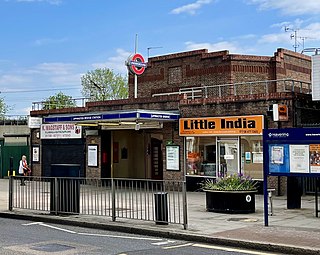
Upminster Bridge is a London Underground station in the Upminster Bridge neighbourhood of Upminster in the London Borough of Havering, east London. It is on the District line between Hornchurch to the west and Upminster to the east. It is 1.2 kilometres (0.75 mi) along the line from the eastern terminus at Upminster and 33 kilometres (21 mi) to Earl's Court in central London where the line divides into numerous branches. The station was opened on 17 December 1934 by the London, Midland and Scottish Railway on the local electrified tracks between Upminster and Barking that were constructed in 1932. The main station building, on Upminster Road, is of a distinctive polygonal design by William Henry Hamlyn. It has relatively low usage for a suburban station, with approximately 1.15 million passenger entries/exits in 2017.

Emerson Park is a London Overground station serving the Emerson Park neighbourhood in Hornchurch in the London Borough of Havering, east London. The station is on the Romford to Upminster Line and is the only intermediate station on that single-track line, 1 mile 64 chains (2.9 km) from Romford, and 1 mile 66 chains from Upminster. The station was opened as Emerson Park Halt in 1909 by the London, Tilbury and Southend Railway on a branch line which had connected Romford with Upminster and Grays since 1893.

Upminster Bridge is a crossing of the River Ingrebourne carrying the A124 road between the suburbs of Hornchurch and Upminster in northeast London, England. The bridge is known to have existed since at least 1375 and the current brick bridge was opened in 1892, replacing a series of wooden bridges. It gave its name to the nearby Upminster Bridge tube station, which opened in 1934, and has also been applied to the neighbourhood around the station in the London Borough of Havering.
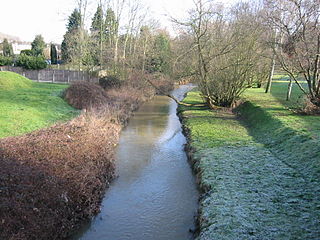
The River Ingrebourne is a tributary of the River Thames 27 miles (43.3 km) in length. It is considered a strategic waterway in London, forming part of the Blue Ribbon Network. It flows through the London Borough of Havering roughly from north to south, joining the Thames at Rainham.
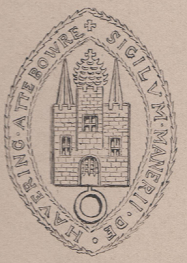
Havering, also known as Havering-atte-Bower, was a royal manor and ancient liberty whose area now forms part of, and gives its name to, the London Borough of Havering in Greater London. The manor was in the possession of the Crown from the 11th to the 19th centuries and was the location of Havering Palace from the 13th to the late 17th century. It occupied the same area as the ancient parish of Hornchurch which was divided into the three chapelries of Havering, Hornchurch and Romford.

Thames Chase is a community forest of 9842 hectares located in 47 sites in London and Essex, England. Its stated aim is "to renew and regenerate the landscape at the edge of East London and South Essex by creating Thames Chase, the Community Forest: a varied wooded landscape for local people to influence, create, use, enjoy and cherish".
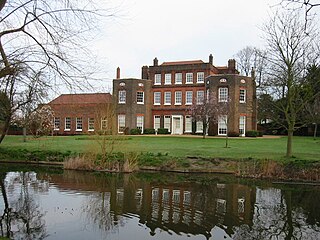
Hornchurch was a local government district in southwest Essex from 1926 to 1965, formed as an urban district for the civil parish of Hornchurch. It was greatly expanded in 1934 with the addition of Cranham, Great Warley, Rainham, Upminster and Wennington; and in 1935 by gaining North Ockendon. Hornchurch Urban District Council was based at Langtons House in Hornchurch from 1929. The district formed a suburb of London and with a population peaking at 131,014 in 1961, it was one of the largest districts of its type in England. It now forms the greater part of the London Borough of Havering in Greater London.

The River Rom, also known as the River Beam below its confluence with the Ravensbourne, is a tributary of the River Thames in England that flows through east London suburbs surrounding the metropolitan centre of Romford, forming the boundary between the London boroughs of Barking and Dagenham and Havering. The Rom is culverted for a brief midsection as it passes through the centre of Romford.
Emerson Park Academy, formerly Hornchurch Grammar School, is an academy school located in the Hornchurch area of the London Borough of Havering, England. It is situated just east of Emerson Park, between Hornchurch and Upminster.
Public transport in the London Borough of Havering, in east London, England, is a mix of National Rail, London Underground, London Overground and Crossrail and London Buses services. Rail services are primarily radial to central London with bus services providing most of the orbital connections. The public transport authority is Transport for London and the local authority is Havering London Borough Council.
Weald Brook is a water feature in the Parliament constituency of Hornchurch and Upminster. Weald Brook flows into River Ingrebourne.